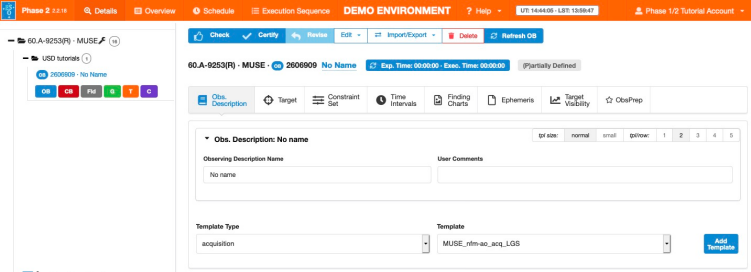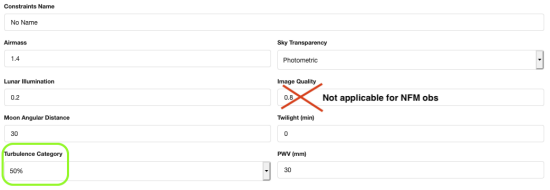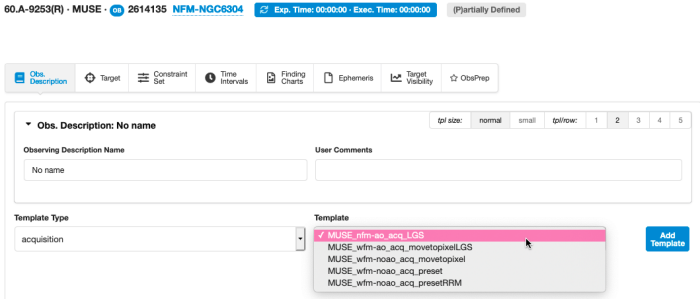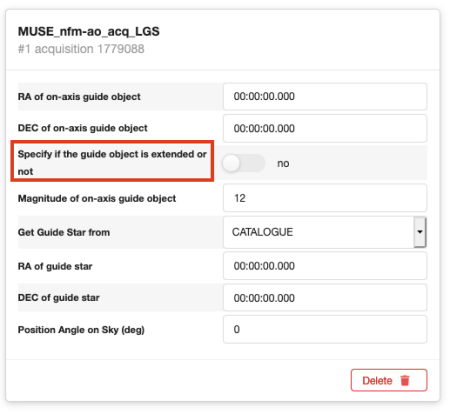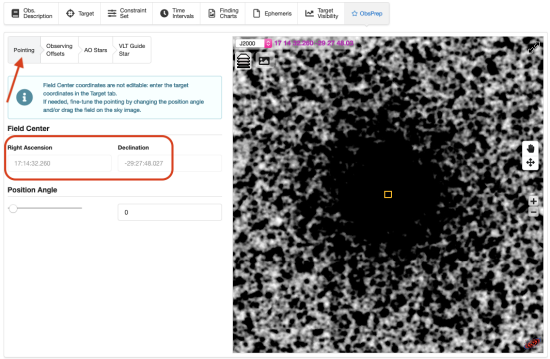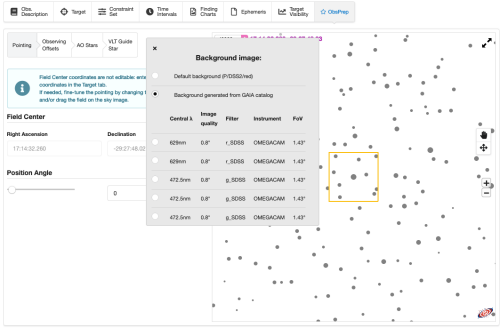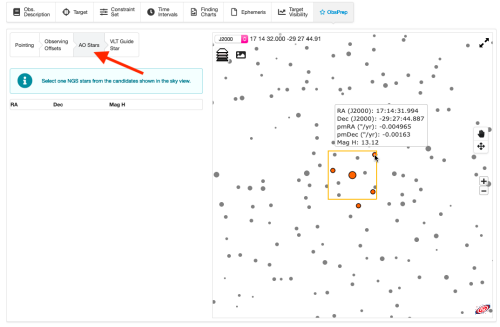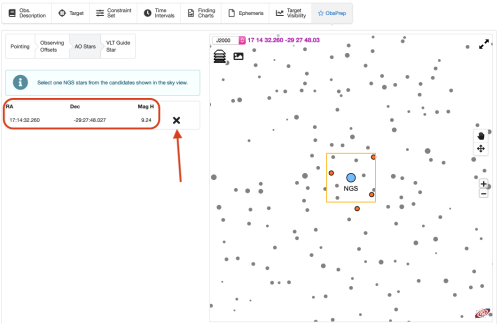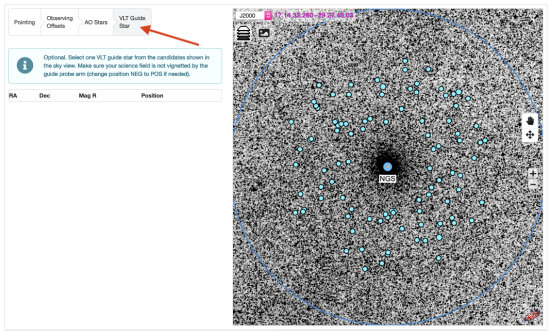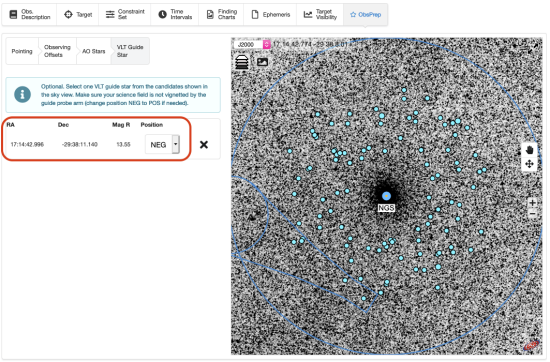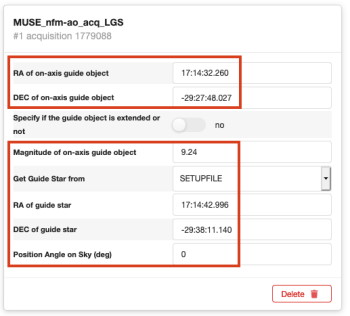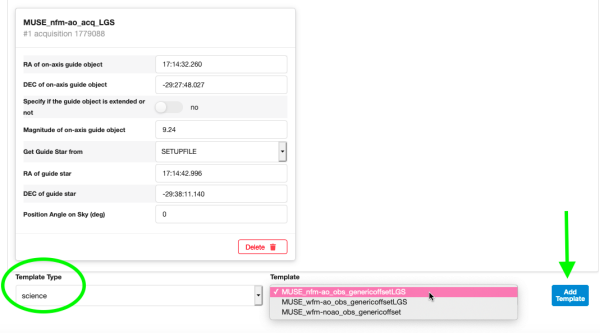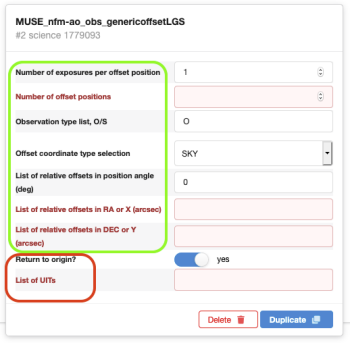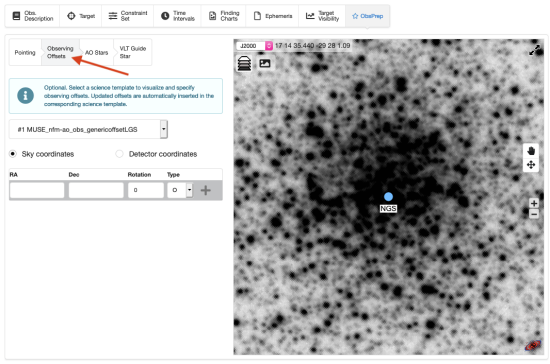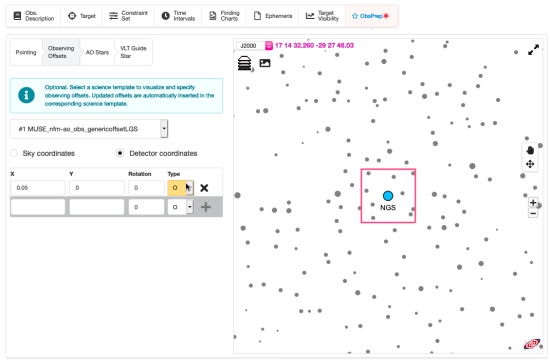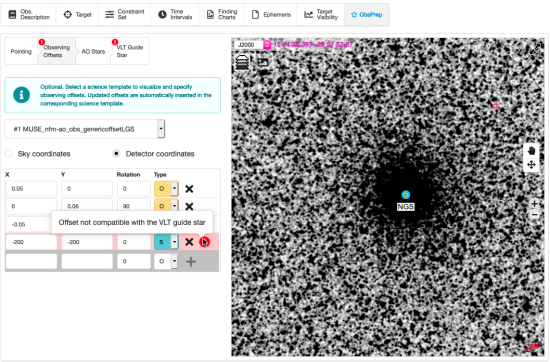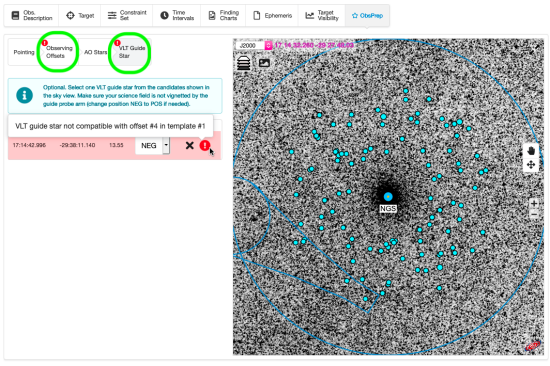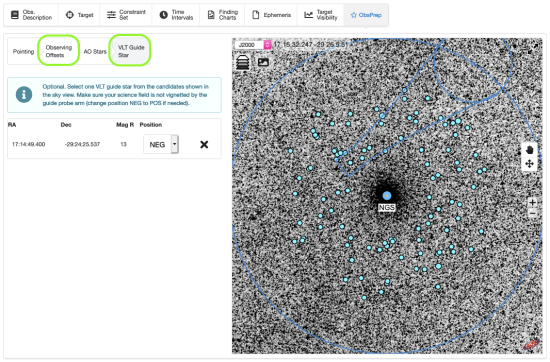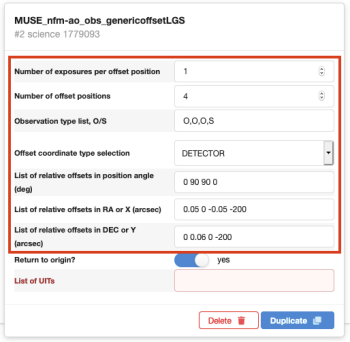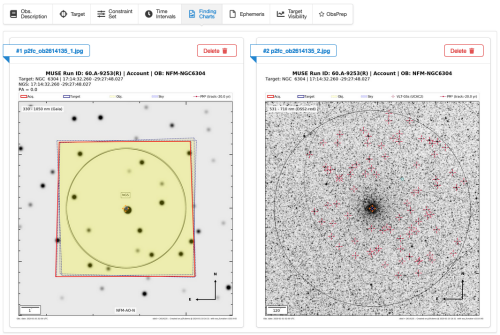MUSE p2 tutorial: NFM observations of a crowded field
The Phase 2 process begins when you receive an email from ESO telling you that the allocation of time for the coming period has finalized and that you can view the results by logging into the User Portal and clicking on "Check the web letters." Note that the username and password that you need to use for the User Portal are the same as those you will use to prepare your OBs.
You follow the instructions given by ESO and find that time was allocated to your run with MUSE. Therefore, you decide to start preparing your Phase 2 material, which consists of a README file, and one or more OBs equipped with finding charts.
In what follows we will discuss and focus on concepts that are only specific to MUSE observations, therefore assuming you have read the p2 documentation and, as such, you are familiar with the general concepts of p2, and its features.
Goal of the run
In this tutorial we will prepare an OB for a simple example observing run, consisting of IFU observations of the globular cluster NGC6304 RA(2000)=17:14:32.260, DEC(2000)=-29:27:48.027, by using the NFM mode. It is intended to provide an example of MUSE observations of a crowded field for which off-target sky monitoring is needed because the field is too dense.
The observing strategy based on the science requirements is:
- NFM
- VLT Guide star selection
- Sky monitored off-target
- On-target integration split in multiple sub-exposures taken at different orientation and position (i.e., dithering + rotation).
Getting started
For the sake of this tutorial, we will use the p2 demo facility, which allows users who do not have their own p2 login data to still use p2 and prepare example OBs (for instance during the Phase 1 preparation to get the overheads right!). You cannot use it to prepare actual OBs intended to be executed. When you prepare OBs that should be executed in PARANAL you must use your ESO User Portal credentials to log into the p2 (with http://www.eso.org/p2).
After directing your browser to the p2, and creating an empty new OB under your SM MUSE run ID by clicking on the OB icon, the main p2 GUI will appear as follows (note that the p2 GUI is regularly updated and might look slightly different):
OB general sections
Your newly created OB consists of general (Target, Time Intervals, Finding Charts, Ephemeris, Target Visibility) and instrument specific (Obs. Description, Constraint Set and ObsPrep) sections that in the figure below are highlighted in red and green, respectively. Each section is accessible through the corresponding tab that appears just below the OB name.
Filling the general OB sections should be fairly straightforward (i.e. Target name, RA and DEC etc..) because each field has its own mini help accessible to users when moving the mouse over it. However, should you need more detailed instructions please consult this page.
OB instrument specific sections
1. Constraint Set
By clicking on to the Constraint Set tab you access the corresponding section, where you will have to provide constraints on airmass, Sky Transparency (i.e., Photometric, Clear, Variable thin cirrus, Variable thick cirrus), Lunar Illumination, Image Quality, Moon Angular Distance, Twilight (min) and Precipitable Water Vapor (mm). While defining the OB constraints you should always remember that Phase 2 constraint must agree with Phase 1 request. Details on each specific constraint (i.e., range and meaning) can be found in the general and specific observing conditions pages.
Screenshot of the Constraint Set section. Note that the Image Quality constraint is only applicable for the WFM cases (both AO and NOAO). For NFM observations, the relevant parameter describing the atmosperic condition in terms of seeing (at zenith and in V-band) and coherence time, is the Turbulence Category requested in your proposal after consulting the ETC. Note: obtaining good AO performance, specially at blue wavelengths, is very challenging and it is only possible in the very best seeing conditions, close to zenith. This is why NFM observations are allowed only for Turbulence Categories: 10%, 20%, 30%, 50% and at relatively low airmass values. In addition, when a faint NGS (18.5<J<19) is used the airmass cannot be larger than 1.2.
2. Obs. Description: the Acquisition template
The Obs. Description section should be regarded as the core of any given OB bacause it contains the details of the observations, arranged in templates. Each OB must have an acquisition and one or more science templates.
Selecting the right acquisition template
The instrument mode is defined in the acquisition template, therefore each mode has its own dedicated acquisition template. As summarised in this table, for the case of LTAO observations there is just one possible acquisition template (MUSE_nfm-ao_acq_LGS).
In this case the target field is very crowded, therefore to monitor the sky background an off-target exposure is needed. In addition, we will select a star as VLT-GS to make sure that it is compatible with the fairly large offset defined in the OB in order to monitor the sky in a nearby sparse region.
To load the acquisition template into the OB click on to the Obs. Description tab to access the corresponding section and select the acquisition template as shown in the picture below. Then click on the "Add Template" button to access the content of the template.
To the top
Filling the acquisition template
The set of acquisition parameters appearing on the p2 GUI after loading the MUSE_nfm-ao_acq_LGS template can either be defined completely manually or in a more automatic way by using ObsPrep.
In what follows we first provide a short desciption of each parameter, and then we will use ObsPrep to fill in the template.
- RA of on-axis guide object: RA coordinate of the Natural Guide Stra (NGS, see special note below)
- DEC of on-axis guide object: DEC coordinate of the NGS
- Specify if the guide object is extended or not: If set to 'yes' special requirements for the J-band magnitude of the NGS apply (see below)
- Magnitude of on-axis guide object: J-band magnitude of the NGS
- Get Guide Star from: If left to CATALOGUE then the VLT-GS is selected by the telescope operator (see note below)
- RA of guide star: RA coordinate of the VLT guide star (VLT-GS, see dedicated note below)
- DEC of guide star: DEC coordinate of the VLT-GS
- Position Angle on Sky (deg): Orientation of the MUSE FoV
Special Note on the VLT-GS:
Suitable VLT-GS should not be closer than 4' from the MUSE field center but still within the VLT unvignetted FoV (i.e. within 11' radius) and should have a magnitude in the range: 11<R<13.5. The position of the selected VLT-GS is provided by the user in the acquisition template through the star's absolute coordinate (i.e. RA of guide star, DEC of guide star). The parameter Get guide Star from must be set to SETUPFILE in case a specific star is given. Finally, the selection of the VLT-GS is optional, however users are encouraged to define a VLT-GS in the OBs in case the observing strategy requires: i) stacking together multiple OBs of very sparse fields lacking a sufficient (i.e., > 5) point sources-like (i.e., by selecting for all similar OBs the same VLT-GS you can rely on the accuracy and consistency of the coordinates and offsets stored in the header of all raw frames you will combine); ii) mosaicking a large area; iii) performing very large offsets (i.e., for sky monitoring purpose).
Special Note on the NGS:
Any stars (point-like sources) satisfying the following criteria can be used as NGS:
- Its distance from the instrument FoV center is up to 5.0"
- The NGS is fainter than J=5.5 (Vega)
- For a target-NGS separation <3":
- The NGS magnitude is J<19 if TC=10% and AM<=1.2
- The NGS magnitude is J<18.5 if TC>10% or AM>1.2.
- For a target-NGS separation is >=3":
- The NGS magnitude is J<18 if TC=10% and AM<=1.2
- The NGS magnitude is J<17.5 if TC>10% or AM>1.2.
- the magnitude within a 1.5” aperture from the centroid is in the range 5.5<J (Vega)
- Its distance from the instrument FoV center is up to 3.35"
Screenshot of the selected acquisition template.
Parameters highlighted with the red boxes must be defined manually in the acquisition template, whereas the remaining can be specified by using ObsPrep.
3. ObsPrep: the Acquisition template
Assuming that you have already partially filled in the Target section with at least the target coordinates RA and DEC, by clicking on the ObsPrep tab, the p2 main GUI appears as follows (note that the screenshots refer to the ObsPrep version in P105; additional functionalities were added later):
ObsPrep Pointing
Screenshot of the ObsPrep-Pointing GUI showing the position of the MUSE FoV as defined in the Target section. Note that the coordinates Alpha and Delta (highlighted with the red box), previously defined in the Target section, are automatically propagated to the ObsPrep-Pointing tab (see red arrow), and a DSS image around the pointing is shown in the right GUI. The MUSE NFM FoV footprint is marked in yellow. You can zoom in/out by using the +/- buttons on the right-hand side of the GUI, or even change the background displayed image by clicking on the picture icon (second icon on the upper left-hand side of the GUI). Should you need to fine-tune the exact target centering you can do that directly on the GUI by dragging the yellow footprint on the desired position (i.e., see the instructions outlined in the blue box), and the tool will update the Alpha and Delta coordinates accordingly in all corresponding fields (i.e., not only in ObsPrep-Pointing tab, but also more importantly in the Target section). Finally, should you need it, the field orientation can be modified either by using the Position-Angle bar or inserting the value in the Position-Angle field.
Screenshot of the ObsPrep-Pointing GUI after having zoomed in and changed the backgroud image from DSS (default) to a mock image generated by using the Gaia DR2 catalog.
ObsPrep NGS selection
Screenshot of the ObsPrep-AO Stars GUI highlighting the position of all suitable stars (marked as orange big dots, and taken from the Gaia-DR2 catalog) to be used as NGS. Moving the mouse over any of the marked stars you have access to its position, proper motions and extrapolated J-band magnitude. Note: because ObsPrep uses Gaia-DR2 stars catalog, it does not display extended objects. Therefore, should you need to use an extended object as NGS then you must manually insert its RA and DEC coordinates in the corresponding acquisition template fields.
Screenshot of the ObsPrep-AO Stars GUI after having selected one of the available NGS directly on the image. Upon selecting a NGS on the image, the tool labels it as 'NGS', and it populates the relevant fields accordingly (i.e., see fields on the left-hand side of the ObsPrep-AO Stars tab highlighted with the red box). Note that the fields are not editable, therefore should you need to change the NGS you must first click on the X button (trash bin in new ObsPrep version), and then select a new star directly on the image.
ObsPrep VLT Guide Star
Screenshot of the ObsPrep-VLT Guide Star GUI showing the position of suitable VLT-GSs (cyan big dots, and taken from the Gaia-DR2 catalog) and the telescope patrol field (blue big circle) with respect to the defined target and reference star position. Moving the mouse over any of the marked stars you have access to its position, proper motions and magnitude.
Screenshot of the ObsPrep-VLT Guide Star GUI after having selected a VLT-GS directly on the image. In doing so the tool populates the relevant fields accordingly (i.e., see fields on the left-hand side of the GUI highlighted with the red box). Note: the VLT-GS selection constrains the allowed offsets during the science observations, therefore when the observing strategy requires performing large offsets, it is highly recommended to select the VLT-GS only after having defined the offsets in the science template.
Now, if you go back to the acquisition template under the Obs. Description section you will notice that all relevant template parameters have been properly propagated by ObsPrep (see figure below). Specifically, the Alpha/Delta coordinate of the VLT-GS and NGS.
Screenshot of the acquisition template once all relevant information (see red box) has been inserted by using ObsPrep.
4. Obs. Desciption: the Science template
The only available science template for WFM-AO observations is the MUSE_nfm-ao_obs_genericoffset. To load it into the OB, first select the option science in the drop down menu "Template Type", then select the MUSE_nfm-ao_obs_genericoffset from the drop down menu on the right and click on the "Add Template" icon as shown in the figure below.
As for the Acquisition case, the set of science parameters appearing on the p2 GUI after loading the MUSE_nfm-ao_obs_genericoffsetLGS template can either be defined completely manually or in a more automatic way by using ObsPrep.
In what follows we first provide a short desciption of each parameter, and then we will use ObsPrep to fill in the template.
- Number of offset positions: Number of positions at which you want to take exposures
- Number of exposures per offset position: Number of exposures to be taken at any defined position
- Observation type list, O/S: Each defined exposure must be tagged either as 'O' for on-target observations, or as 'S' for sky monitoring (see sec. 5.4 of User Manual).
- Offset coordinate type selection: The offsets pattern can be defined either in DETECTOR or SKY coordinates system (see sec. 5.4 of User Manual).
- List of relative offsets in position angle (deg): The field orientation at each defined offset position (offsets in position angle are cumulative). See Special Note below.
- List of relative offsets in RA or X (arcsec): Offset in RA/X of each defined position (offsets are cumulative). See Special Note below.
- List of relative offsets in DEC or Y (arcsec): Offset in DEC/Y of each defined position (offsets are cumulative).
- Return to origin?: This flag is set always to "Yes", meaning that the telescope returns to the original position after the defined offsets pattern is completed. Note that the original position matches the telescope pointing before the science template has started (i.e., after the acquisition). Should you need to set this keyword to "No" you must submit a waiver.
- List of UITs: Integration time (in seconds) of each defined exposures. If all defined exposures must be taken with the same integration time you can just type in a single value.
Note on offsets and field orientation:
To improve the flat-fielding of the slicer and channel patterns during the data reduction we strongly advise the observer to always split the on-target observation in multiple exposures taken at least at two different position angles (separated by 90 degrees) and with a small offsets pattern. The size of each on-object offset should at least be larger than a spaxel (i.e. >25 mas for the NFM). However, rotation is allowed only when the NGS is on-axis (i.e., NGS is located within 20mas from the FoV center).
In addition:
ON-OBJECT OFFSETS: the maximum size of the offsets between two consecutive on-object exposures should not be larger than 1” (i.e., 40 pixels). This limitation is driven by the need of keeping the lasers and NGS loops closed during the offsets.
ON-OBJECT OFFSETS & ROTATIONS: When the NGS is on-axis (i.e., target is the NGS), on-object exposures taken at different position angles should keep the NGS always within 0.2" (8 pixels) from the original position, where the original position matches the location of the NGS before any rotation is applied (i.e., before the first science template starts).
Screenshot of the selected science template.
Parameters highlighted with the red boxes must be defined manually in the science template, whereas those enclosed by the green box can be specified by using ObsPrep.
5. ObsPrep: the Science template
To prepare the science observing sequence we will make use of ObsPrep. To this end go back to the ObsPrep section and click on the Observing Offsets tab. The main P2 GUI will appear as follows:
ObsPrep Observing Offsets
Screenshot of the ObsPrep Observing Offsets showing the position of the selected NGS (big blue dot). The coordinates reference system for the offsets (i.e., Sky or Detector) can be directly selected in the left-hand side of the GUI, together with the list of offsets in RA, Dec and position angle. The type of exposure (i.e., O or S) can be also defined for each offset.
To obtain the best results in terms of cosmics rejection and to improve the flat-fielding of the slicer and channel patterns during the data reduction, we plan to split the total integration time on source into 3 exposures, each one rotated by 90 degrees and taken at a different position. Note that the number of exposures and their exposure time should be defined with the help of the ETC to ensure the requested S/N is reached with respect to the total integration time on source. In addition, because the target is very extended with respect to the instrument FoV, an off-target offset exposure to monitor the sky background is necessary. These requirements imply the definition of 4 exposures, 3 tagged as 'O' type (i.e., on-object so all AO loops are kept closed) and just 1 as 'S' type (i.e., sky so NGS loop is open during the exposure). Finally, we highly recommend to spend on "SKY" a minimum of 150 sec, otherwise the sky lines used by the pipeline for fine-tuning the wavelength solution would result not optimal.
Screenshot of the ObsPrep-Observing Offsets GUI showing the position of the MUSE FoV corresponding to the position defined by the first offset. The first offset has been included by inserting the values 0.05 and 0 in the RA and Dec fields, respectively (see left-hand side of the GUI), and then pressing the + button next to the offset type field.
Screenshot of the ObsPrep Observing Offsets GUI showing the position of the MUSE FoV corresponding to the positions defined in the offset list (see left-hand side of the GUI). To define any given offset you must fill in the RA, Dec, Rotation and type fields, and then pressing the + button next to the offset type field. The the instrument FoV footprint corresponding to each exposure is also shown on the image. By moving the mouse over any of the defined object in the left-hand side GUI the corresponding location on the image is highlighted in pink. The red circle symbol appearing next to the last defined offset highlight a problem with the selected VLT-GS. Therefore, as already anticipated (see above), we must change the VLT-GS.
Screenshot of the ObsPrep VLT Guide Star GUI after having selected the observing offsets, which turn out to be not compatible with the previously selected VLT-GS. By moving the mouse over the red big circle you have access to a mini-help window that tells you which defined offsets is not compatible to the selected VLT-GS. To change the VLT-GS click on the X button and then select another star as done previously.
By selecting a new VLT-GS, all the warnings (i.e., red ! circles) next to the Observing Offsets and VLT Guide Star tabs disappeared (i.e., compare the region highlighted by the green box in this figure and in the previous one).
Now, if you go back to the science template (i.e., in the Obs. Description section) you will notice that most of the parameters have been properly propagated by ObsPrep (see figure below). Specifically, all but the list of UITs that you must fill in manually.
Screenshot of the science template once most of the relevant information (see red box) has been propagated by using the Observing Offsets feature within ObsPrep. Note that the list of exposure times must be inserted manually.
Finding charts
At this point you must create finding charts compliant with ESO general and MUSE specific requirements. The easiest and quickest way to do that is by using the finding charts generator embedded in the p2 environment. Once the OB templates content has been fully provided, click on the "Generate Finding Chart" button you find under the Finding Charts section. In doing that 2 finding charts will be created and automatically attached to the OBs. Specifically, the tool produces a finding chart showing the position of the selected VLT-GS with respect to the telescope pointing (i.e., large field of view chart showing the telescope patrol field), and a second one showing the MUSE FoV footprint centred on the reference star selected for the accurate target centering onto the target field showing the final centering.
Screenshot of the finding charts created by the Finding Charts Generator. The left image is zoomed onto the target field and it shows the position of the FoV during the acquisition (i.e., red square) and during the defined science offsets pattern (i.e., blue-dotted footprints shadowed in yellow). The right-hand image shows a zoomed out version of the first finding chart, in which the selected VLT-GS, the position of the telescope patrol field (i.e., big circles) and the instrument FoV position during all defined offsets are marked.
Alternatively, you can provide your own-made finding charts (please consult this page to check all the requirements), which you must manually attach to the OB (i.e., click on the "Upload Finding Chart" button you find in the Finding Charts section).
Access to the final OB
The ascii version of the OB just created, together with the corresponding finding charts can be downloaded here.
Alternatively, by logging into p2 demo, under the programme ID 60.A-9253(R) you can access to the USD-Tutorials folder where this OB have been created and stored. In the same folder you can also find a sample of OBs designed for different modes and observing strategy. The example OBs are not editable but can be exported if needed. We kindly ask you to please refrain from creating new OBs in the USD-Tutorials folder.
Instrument selector
MUSE p2 tutorial
- Goal of the run
- Getting started
- OB general sections
- OB instrument specific sections
- Finding charts
- Access to final OB
- Back to MUSE p2 tutorial main page
P2 documentation
Useful links

